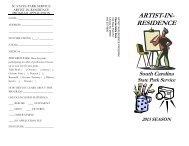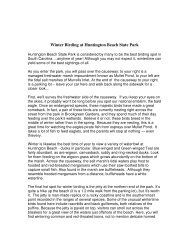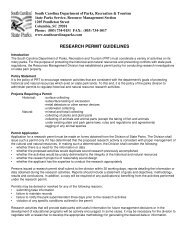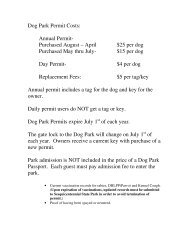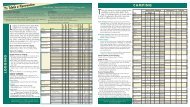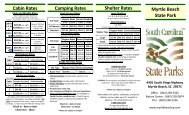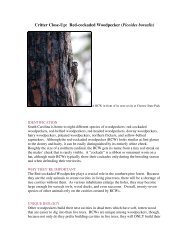Myrtle Beach State Park Beachcombing Guide - South Carolina Parks
Myrtle Beach State Park Beachcombing Guide - South Carolina Parks
Myrtle Beach State Park Beachcombing Guide - South Carolina Parks
Create successful ePaper yourself
Turn your PDF publications into a flip-book with our unique Google optimized e-Paper software.
<strong>Myrtle</strong> <strong>Beach</strong> <strong>State</strong> <strong>Park</strong><br />
<strong>Beach</strong>combing <strong>Guide</strong><br />
The following pages are designed to help you identify<br />
some of the common beachcombing treasures found at<br />
<strong>Myrtle</strong> <strong>Beach</strong> <strong>State</strong> <strong>Park</strong>. Many other species of marine<br />
life may be found that are not included in this guide.<br />
<strong>Beach</strong>combing Tips:<br />
*Never take live animals– return them safely back into the water.<br />
Always protect our precious marine resources for the future!<br />
*If you find a snail shell, you can tell it’s<br />
alive if something is still in there. The<br />
shell will keep growing as the snail<br />
grows. The snail will not and cannot<br />
move to a new shell!<br />
*The best time to go beachcombing is around low tide and after<br />
storms. The best places to look are at the waters edge and the wrack<br />
line or high tide line.<br />
*<strong>Myrtle</strong> <strong>Beach</strong> and Huntington <strong>Beach</strong> <strong>State</strong> <strong>Park</strong>s<br />
can be great places to go beachcombing.<br />
*Remember to always use<br />
a boardwalk or designated<br />
path to reach the beach<br />
and always stay off the<br />
sand dunes.<br />
All photos by Ann Malys Wilson and Terry Conway<br />
Florida Horse Conch– live<br />
Sand Dune<br />
Wrack Line
Bivalves– “two shells”<br />
Ponderous Ark– Noetia ponderosa<br />
Eastern Oyster<br />
Crassostrea virginica<br />
Atlantic Jackknife/<br />
Razor Clam<br />
Ensis directus<br />
Cross-barred Venus Clam<br />
Chione cancellata<br />
Common Jingle– Anomia simplex<br />
Atlantic Wing Oyster<br />
Pteria colymbus<br />
Shells can be divided into two main groups:<br />
Bivalves & Gastropods (Univalves)<br />
Bivalves, such as oysters and clams, have<br />
two shell sections connected by a hinge. When<br />
the bivalves die, the two shells usually break<br />
apart from each other.<br />
Gastropods, such as whelks and moon<br />
snails, have a single shell that usually grows in a<br />
spiral.<br />
<strong>Myrtle</strong> <strong>Beach</strong> <strong>State</strong> <strong>Park</strong>
Bivalves– “two shells”<br />
Sawtooth Penshell– Atrina serrata<br />
Stiff Penshell– Atrina rigida (right photo) Mussels– different species<br />
Calico Scallop<br />
Argopecten gibbus<br />
Coquina Clams– Donax variabilis<br />
Cockle Shells<br />
different species<br />
Northern Quahog<br />
Mercenaria mercenaria<br />
Live Coquina Clams:<br />
All live shells should always be<br />
returned to the ocean. Help<br />
protect our precious<br />
ocean resources!<br />
<strong>Myrtle</strong> <strong>Beach</strong> <strong>State</strong> <strong>Park</strong>
Gastropods– “stomach foot”<br />
Lettered Olive<br />
SC <strong>State</strong> Seashell<br />
Oliva sayana<br />
Atlantic Slipper Snail<br />
Crepidula fornicata<br />
<strong>Myrtle</strong> <strong>Beach</strong> <strong>State</strong> <strong>Park</strong><br />
Atlantic Moon Snail– Neverita duplicata<br />
The small hole was drilled by another moon<br />
snail. They do this when capturing their<br />
prey. Look for a single perfect hole made by<br />
a moon snail in other shells.<br />
Banded Tulip<br />
Fasciolaria hunteria<br />
Atlantic Auger<br />
Terebra dislocata<br />
This is a picture of a live<br />
auger. Always release live<br />
shells!<br />
Baby’s Ear<br />
Sinum perspectivum<br />
Sand Collar<br />
moon snail egg case
Gastropods– “stomach foot”<br />
Cayenne Keyhole Limpet- Diodora cayenensis<br />
Channeled Whelk<br />
Busycon canaliculata<br />
Opening on left<br />
Whelk Egg Case<br />
Lightning Whelk– Busycon sinistrum<br />
Live whelks (right<br />
picture) cannot<br />
survive long<br />
periods of time<br />
out of the ocean.<br />
Please return any<br />
live shells back<br />
Florida Horse Conch<br />
Pleuroploca gigantea<br />
This is not a true conch!<br />
Opening<br />
on right<br />
Knobbed Whelk– Busycon carica<br />
Operculum– this is attached<br />
to the whelks foot<br />
<strong>Myrtle</strong> <strong>Beach</strong> <strong>State</strong> <strong>Park</strong>
Coral<br />
Other Common <strong>Beach</strong>combing Finds<br />
Barnacles and Mussels<br />
on Pier Pilings<br />
<strong>Myrtle</strong> <strong>Beach</strong><br />
<strong>State</strong> <strong>Park</strong><br />
Sea Whips (Soft Coral)<br />
Leptogorgia virgulata<br />
Horseshoe Crab<br />
Limulus polyphemus<br />
Mole Crab<br />
Emerita talpoida<br />
Ghost Crab– Ocypode quadrata<br />
This crab lives in burrows along<br />
the beach. Please do not disturb<br />
their burrow!<br />
Harmless Jellyfish<br />
Cannonball Jelly– Stomolophus meleagris<br />
Spider Crab– Libinia spp.
Other Common <strong>Beach</strong>combing Finds<br />
Purple Sea Urchin (live)<br />
Arbacia punctulata<br />
Sponge (dead)<br />
Sargasso Seaweed<br />
Sargassum spp<br />
Parchment Tube Worm (dead)<br />
Chaetopterus variopedatus<br />
Sponge (live)<br />
Codium- Codium spp<br />
Green Algae<br />
Sea Pork (dead)<br />
Serpulid Tube Worms on a dead<br />
Keyhole Urchin (Mellita quinquiesperforata)<br />
<strong>Myrtle</strong> <strong>Beach</strong> <strong>State</strong> <strong>Park</strong>



